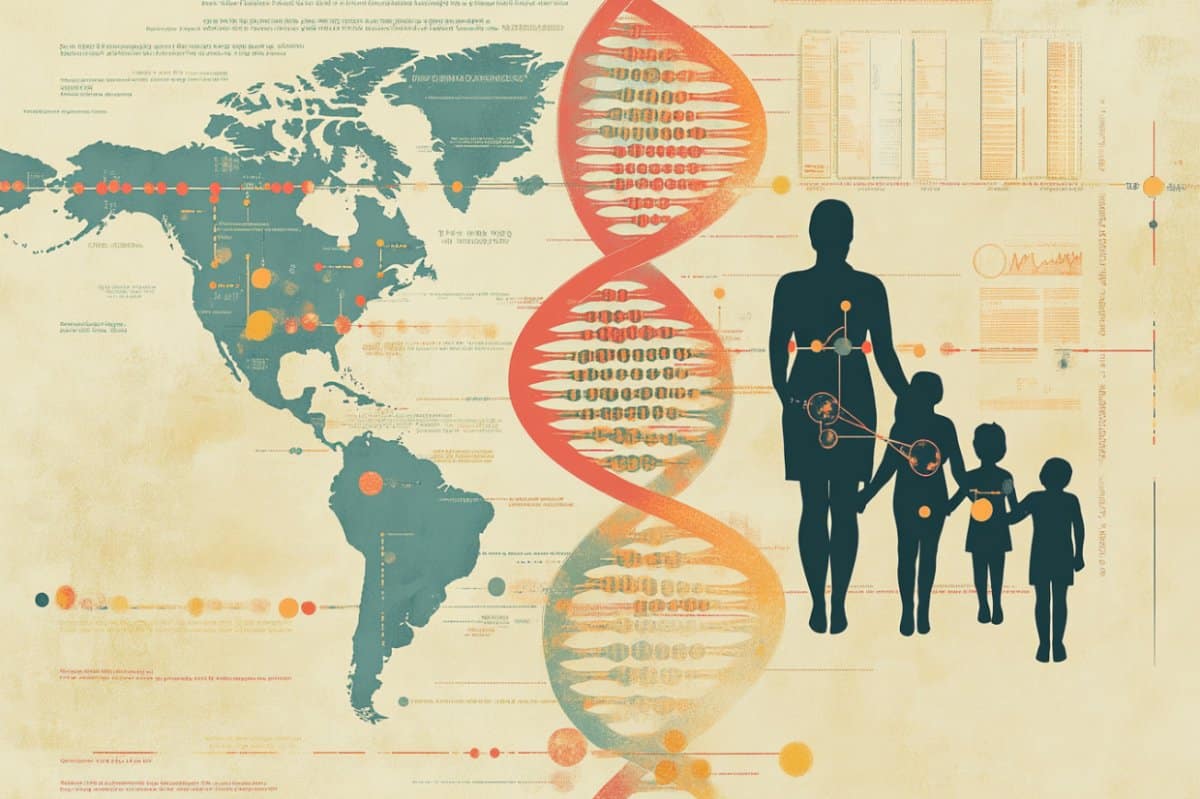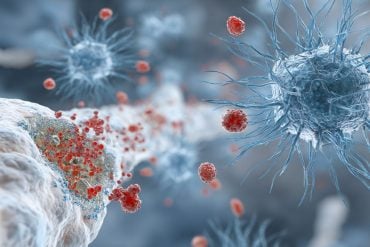Summary: A massive genomic study has revealed that parental age, ancestry, and smoking habits subtly influence the number of new genetic mutations (de novo mutations) passed from parents to children. By analyzing whole-genome data from 10,000 parent-child trios, researchers found that most variation in mutation rates comes from parental age, especially the father’s.
However, small differences were also observed between ancestry groups and in children of parents with a smoking history. These findings challenge the assumption that mutation rates are uniform across populations and environments.
Key Facts:
- Age Dominates: Paternal age adds ~1.5 mutations per year; maternal age adds ~0.4.
- Ancestry Differences: Slightly higher mutation rates seen in African ancestry groups.
- Smoking Effect: Parental smoking linked to a ~2% increase in mutation count in offspring.
Source: Wellcome Sanger Institute
Ancestry and lifestyle choices of parents may affect the rate and type of new genetic changes that arise in their children, new research has found.
Published in Nature Communications (15 May), researchers from the Wellcome Sanger Institute, the University of Cambridge and their collaborators analysed whole-genome sequence data from 10,000 parent-child ‘trios’.
They studied the influence of ancestry, common genetic variants and environmental factors on the rates and types of de novo mutations (DNMs) – genetic changes that arise in the egg or sperm and are passed down to offspring.

The study sheds light on factors that influence the rate and patterns of new genetic variation in humans. The results will also inform future studies in population and medical genetics in which models of mutation rate are important parameters.
Germ cells – eggs and sperm – maintain integrity of genetic information which is passed down to children. While most new changes occurring in the DNA tend to be either harmless or mildly detrimental, a small fraction can lead to severe genetic conditions.
As a result, the mutation rate in germ cells is kept exceptionally low to reduce the risk of passing on harmful changes.
Whilst scientists know that increasing parental age – particularly paternal age – is linked with more genetic changes in germ cells, this factor only explains a certain amount of variation in mutation rate.
Aside from effects of chemotherapy and rare variants in genes involved in DNA repair, little is known about other factors influencing the rate of DNMs.
In a new study, researchers sought to explore the influence of ancestry, common genetic variants and smoking on rates and patterns of DNMs that arise in children.
They conducted the largest study of DNMs to date, analysing around 10,000 whole genomes of parent-child ‘trios’ – two parents and their child – from the 100,000 Genomes Project.
By comparing each child’s DNA with that of their parents, the scientists could identify new genetic variants that arose in the egg or sperm and were passed on to the child, but which were not present in the parents’ genomes. This approach allowed the team to build a catalogue of nearly 690,000 DNMs.
The study revealed that different ancestry groups have small differences in the number of new genetic mutations passed to children – for example, there was an average of about 64 new DNMs per generation in European, American, and South Asian groups, compared to about 67 in African groups.
However, parental age, especially the father’s age, has a much bigger impact. Each year of a father’s age adds around 1.5 mutations, whereas each year of a mother’s age adds about 0.4. So, the difference between parents with African versus other genetic ancestries is about the same as having a father who is two years older.
The researchers suggest that the differences could stem from environmental influences and/or genetic factors that differ between populations.
Interestingly, they did not find any evidence that common genetic variation influences rates of DNMs within people of European ancestry, although this does not rule out that average genetic differences between ancestry groups contribute to differences in DNM rate.
The research also uncovered a link between parental smoking and higher DNM rates in children.
The scientists found that children of parents who had documented smoking history in their health records showed a small but statistically significant increase in the number of DNMs, compared to children of non-smokers. The analysis suggests an average of roughly two per cent rise in mutation count.
The effect is very small – the equivalent of less than one additional DNM per smoking parent over their reproductive lifespan, similar to the effect of having the father be a year older at the time of conception.
The researchers note that it is too early to say whether parental smoking directly causes these new mutations, as it may just be associated with other mutagens.
However, this study is a significant step forward in looking at how the genetic ancestry and lifestyle of parents correlate with rates of new genetic changes.
These findings may have an influence on future genetic studies on population history and dynamics, as well as studies seeking to identify genes implicated in rare disorders using DNMs.
These studies currently assume the same rate and pattern of DNA changes for all ancestry groups. It is possible that adjustments to current models to take into account these new findings may make them more powerful or help refine conclusions.
“The sheer scale of the 100,000 Genomes Project presented a great opportunity to look into the effects and exposures that explain rates and patterns of DNA changes.
“The takeaway is that rates of de novo mutation are mostly driven by parental age, but ancestry and environmental factors such as smoking may make a small imprint.”
Dr Aylwyn Scally,co-senior author at the University of Cambridge, commented.
“Whilst evolution has done its best to develop mechanisms to protect the DNA we pass on to our offspring, our study has shown that it’s not fully protected from certain exposures.
“Future studies on larger datasets and with richer data on environmental exposures may reveal additional important factors that influence variation in de novo mutation rate.”
Dr Raheleh Rahbari,co-senior author and Group Leader at the Wellcome Sanger Institute, said.
“New genetic changes that arise in egg or sperm cells give rise to genetic diversity within a population, making each one of us unique, but they can also cause rare genetic disorders.
“In our study, we’ve been able to see for the first time that a person’s ancestry and even lifestyle choices of their family, such as smoking, are associated with the number of new DNA changes that arise in their genome.
“These effects are small, but nonetheless these findings increase our understanding of factors associated with this fundamental biological process,” said Dr Hilary Martin,co-senior author and Group Leader at the Wellcome Sanger Institute.
Funding
The research was funded by the National Institute for Health Research and NHS England who fund The National Genomic Research library. Wellcome, Cancer Research UK and the Medical Research Council also funded the research. Full details of acknowledgements can be found in the publication.
About this genetics research news
Author: Communications Team
Source: Wellcome Sanger Institute
Contact: Communications Team – Wellcome Sanger Institute
Image: The image is credited to Neuroscience News
Original Research: Open access.
“The impact of ancestral, genetic, and environmental influences on germline DNM rates and spectra” by Garcia-Salinas, O. I. et al. Nature Communications
Abstract
The impact of ancestral, genetic, and environmental influences on germline DNM rates and spectra
De novo germline mutation is an important factor in the evolution of allelic diversity and disease predisposition in a population.
Here, we study the influence of genetically-inferred ancestry and environmental factors on de novo mutation rates and spectra.
Using a genetically diverse sample of ~10 K whole-genome sequenced trios, one of the largest de novo mutation catalogues to date, we found that genetically-inferred ancestry is associated with modest but significant changes in both germline mutation rate and spectra across continental populations.
These effects may be due to genetic or environmental factors correlated with ancestry.
We find epidemiological evidence that cigarette smoking is significantly associated with increased de novo mutation rate, but it does not mediate the observed ancestry effects.
Investigation of several other potential mutagenic factors using Mendelian randomisation showed no consistent effects, except for age at menopause, where factors increasing this corresponded to a reduction in de novo mutation rate.
Overall, our study sheds light on factors influencing de novo mutation rates and spectra.






